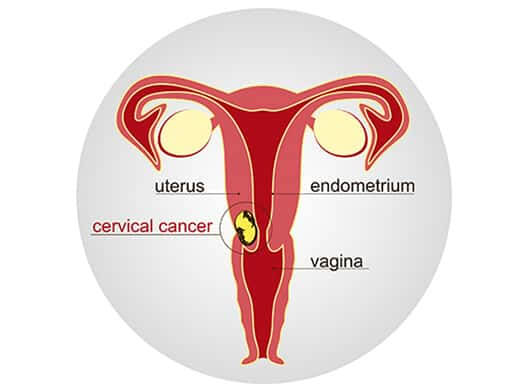- Surgery
- Radiation
- Medical Oncology
- Early-stage cervical cancer is typically treated with surgery. The procedure that is best suited for you depends on the size of the lesion and its stage.
- Tumor Resection - For some very small lesions, it might be possible to remove the cancer entirely during a cone biopsy. This procedure involves cutting away a cone-shaped piece of cervical tissue, but leaving the rest of the cervix intact.
- Trachelectomy (Surgery to remove the cervix) - Early-stage cervical cancer might be treated with a radical Trachelectomy procedure, which removes the cervix and some surrounding tissue. The uterus remains after this procedure, so it may be possible to become pregnant, if you choose to.
- Hysterectomy (Surgery to remove the cervix and uterus) - Most early-stage cervical cancers are treated with a radical hysterectomy, which involves removing the cervix, uterus, part of the vagina and nearby lymph nodes. A hysterectomy can cure early-stage cervical cancer and prevent recurrence. Removing the uterus, however, makes it impossible to conceive.
- Minimally invasive (Laparoscopic/ Robotic) Hysterectomy – This involves making several small incisions in the abdomen rather than one large incision, may be an option for early-stage cervical cancer. It has the advantage of a quicker recovery time.
- Radiation therapy uses powerful energy beams, such as X-rays and protons, to kill cancer cells. In some instances, the doctor may recommend radiation to reduce the risk of a cancer recurrence after surgery.
- Radiation therapy can involve:
- External beam therapy - This is done by directing a radiation beam at the affected area of the body (external beam radiation therapy). High precision techniques like Intensity Modulated Radiotherapy (IMRT), Image-guided Radiotherapy (IGRT) and Volumetric Modulated Arc Therapy (VMAT/Rapid Arc) are useful in targeting the tumor accurately and avoiding normal tissue injury.
-
Brachytherapy - This is also called internal radiotherapy as the radioactive source of radiation is placed either very close to the tumor or within the tumor itself. For cervical cancer, Brachytherapy is given by placing tubes within the uterus and the vagina. Radioactive sources are then passed through these tubes, thereby delivering radiation to the cervix and the uterus, with maximal sparing of adjacent normal tissues.
In cervical cancer, intracavitary Brachytherapy alone is advised for very early stages. The rest of the cases require a combination of external beam radiotherapy and Brachytherapy.
If the menopause still hasn’t set-in, there are high chances that radiation therapy might it.
If you wish to conceive post-radiation treatment, your doctor may suggest ways to preserve your ovum before the treatment commences.
- Chemotherapy
- Chemotherapy uses drugs to destroy cancer cells. The indication for chemotherapy is based on the stage of cancer and risk factors.
- Chemotherapy may be used before surgery to shrink large tumors which makes it easier for removal of the tumor.
- Few patients may require chemotherapy after surgery which helps to kill any residual cancer cells. It is also indicated in cases when the disease has spread to other parts of the body.
- Chemotherapy also may be used in cancers where the tumor is inoperable. Sometimes chemotherapy is combined with radiation therapy.
- Targeted drug therapy The indication for targeted therapy is based on molecular changes in the cancer cell. This is usually combined with chemotherapy and may be an option in selected cases. In case of recurrent disease, based on the molecular alterations noted in the tumor, specific targeted therapy may be an option.
-
Immunotherapy is a drug treatment that uses the immune system to fight cancer. The indication for immunotherapy is based on further evaluation and molecular tests in advanced disease and recurrence. Immunotherapy may be considered in a carefully selected group of patients where investigations show that immunotherapy may be beneficial.
For locally advanced cervical cancer, low doses of chemotherapy are often combined with radiation therapy, since chemotherapy may enhance the effects of the radiation. Higher doses of chemotherapy might be recommended to help control symptoms of very advanced cancer.



.png)
